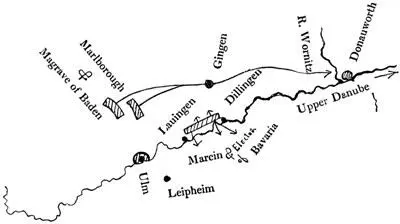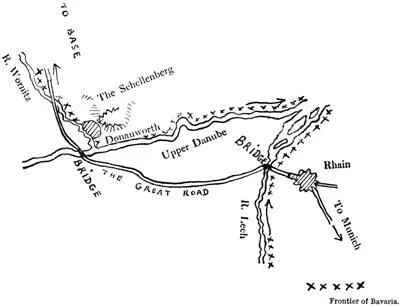The third occupies the last few days only: it is concerned with the manœuvres immediately preceding the battle, and especially with the junction of Marlborough and Eugene, which made the victory possible.
From the junction of Marlborough and Baden to the fall of Donauwörth
When the Duke of Marlborough had joined hands with the forces of Baden upon the 22nd of June 1704 his general plan was clear: the last of his infantry, under his brother Churchill, would at once effect their junction with the rest at Ursprung, and he and Baden had but to go forward.
His great march had been completely successful. He had eluded and confused his enemy. He was safe on the Danube watershed, and within a march of the river itself. The only enemies before him on this side of the hills were greatly inferior in number to his own and his ally’s. His determination to carry the war into Bavaria could at once be carried into effect.
With this junction the first chapter in that large piece of strategy which may be called “the campaign of Blenheim” comes to an end.
Between the successful termination of his first effort, which was accomplished when he joined forces with Baden upon the Danube side of the watershed in the village of Ursprung, and the great battle by which Marlborough is chiefly remembered, there elapsed, I say, seven summer weeks. These seven weeks are divided into the three parts just distinguished.
In order to understand the strategy of each part of those seven weeks, we must first clearly grasp the field.
The accompanying map shows the elements of the situation.
East of the Black Forest lay open that upper valley of the Danube and its tributaries which was so difficult of access from the valley of the Rhine. In the hills to the north of the Danube, and one day’s march from the town of Ulm, were now concentrated the forces of Marlborough and the Duke of Baden. They were advancing, ninety-six battalions strong, with two hundred and two squadrons and forty-eight guns: in all, say, somewhat less than 70,000 men.

Map illustrating the march of Marlborough and Baden across
Marcin’s front from the neighbourhood of Ulm to Donauwörth.
At Ulm lay Marcin, and in touch with him, forming part of the same army, the Elector of Bavaria was camped somewhat further down the river, near Lauingen.
The combined forces of Marcin and the Elector of Bavaria numbered, all told, some 45,000 men, and their inferiority to the hostile armies, which had just effected their junction north of Ulm at Ursprung, was the determining factor in what immediately followed.
Marcin crossed the Danube to avoid so formidable a menace, and took up his next station behind the river at Leipheim, watching to see what Marlborough and the Duke of Baden would do. The Elector of Bavaria, in command of the bridge at Lauingen, stood fast, ready to retire behind the stream. The necessity of such a retreat was spared him. The object of his enemies was soon apparent by the direction their advance assumed.
For the immediate object of Marlborough and Baden was not an attack upon the inferior forces of the Elector and Marcin, but, for reasons that will presently be seen, the capture of Donauwörth, and their direct march upon Donauwörth took them well north of the Danube. On the 26th, therefore, Marcin thought it prudent to recross the Danube. He and the Elector joined forces on the north side of the Danube, and lay from Lauingen to Dillingen, commanding two bridges behind them for the crossing of the stream, and fairly entrenched upon their front. Meanwhile their enemies, the allies, passed north of them at Gingen. This situation endured for three days. 4
When it was apparent that the allied forces of the English general and the Duke of Baden intended to make themselves masters of Donauwörth (and the Elector of Bavaria could have no doubt of their intentions after the 29th of July, when their march eastward from Gingen was resumed), a Franco-Bavarian force was at once detached by him to defend that town, and it is necessary henceforward to understand why Donauwörth was of such importance to Marlborough’s plan.
It was his intention to enter Bavaria so as to put a pressure upon the Elector, whose immediate and personal interests were bound up with the villages and towns of his possessions. The Elector could not afford to neglect the misfortunes of its civilian inhabitants, even for the ends of his own general strategy; still less could he sacrifice those subjects of his for the strategic advantage of the King of France and his marshal.
This Marlborough knew. To enter Bavaria, to occupy its towns (only one of which, Ingolstadt, was tolerably fortified), and if possible to take its capital, Munich, had been from its inception the whole business and strategic motive of his march to the Danube.
But if Marlborough desired to enter Bavaria, Donauwörth was the key to Bavaria from the side upon which he was approaching.
This word “key” is so often used in military history, without any explanation of it which may render it significant to the reader, that I will pause a moment to show why Donauwörth might properly be called in metaphor the “key” of Bavaria to one advancing from the north and west.
Bavaria could only be reached by a general coming as Marlborough came, on condition of his possessing and holding some crossing-place over the Danube, for Marlborough’s supplies lay north of that river (principally at Nördlingen), and the passing of the enormous supply of an army over one narrow point, such as is a bridge over such an obstacle as a broad river, demands full security.
It will further be seen from the map that yet another obstacle, defending Southern Bavaria and its capital towards the west, as the Danube does towards the north, is the river Lech; a passage over this was therefore also of high importance to the Duke of Marlborough and his allies. Now, a man holding Donauwörth can cross both rivers at the same time unmolested, for they meet in its neighbourhood.
Further, Donauwörth was a town amply provisioned, full of warehouse room, and in general affording a good advanced base of supply for any army marching across the Danube. It afforded an opportunity for concentration of supplies, it contained waggons and horses and food. Supplies, it must be remembered, were the great difficulty of each of the two opposed forces, in this moving of great numbers of men east of the Black Forest, in a comparatively poor country, largely heath and forest, and ill populated.

Map showing how Donauwörth is the key of Bavaria from the North-West.
No serious permanent defences, such as could delay the capture of the town, surrounded Donauwörth; but up above it lies a hill, called from its shape “the Schellenberg” or “Bell Hill.” This hill is not isolated, but joins on the higher ground to its north by a sort of flat isthmus, which is level with the summit or nearly so. 5
The force which, on perceiving the Duke of Marlborough’s intention of capturing Donauwörth, the Elector of Bavaria very rapidly detached to defend that town, was under the command of Count d’Arco; it consisted of two regiments of cavalry and about 10,000 infantry (of whom a quarter were French). D’Arco had orders to entrench the hill above the town as rapidly as might be and to defend it from attack; for whoever held the Schellenberg was master of Donauwörth below. But the Elector could only spare eight guns for this purpose from his inferior forces.
Читать дальше














